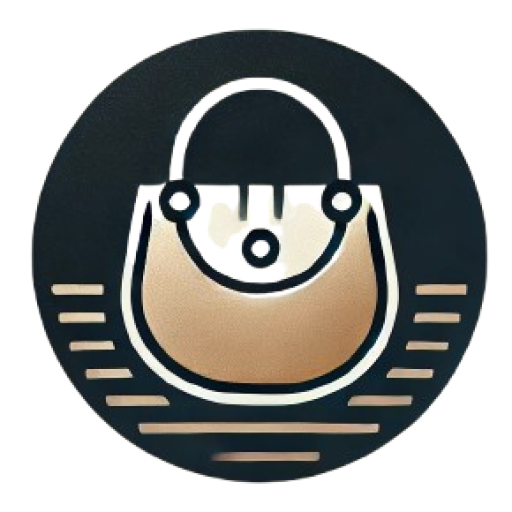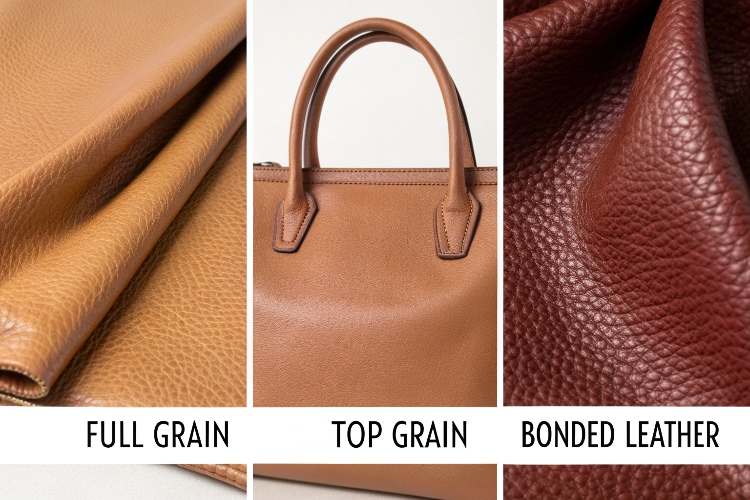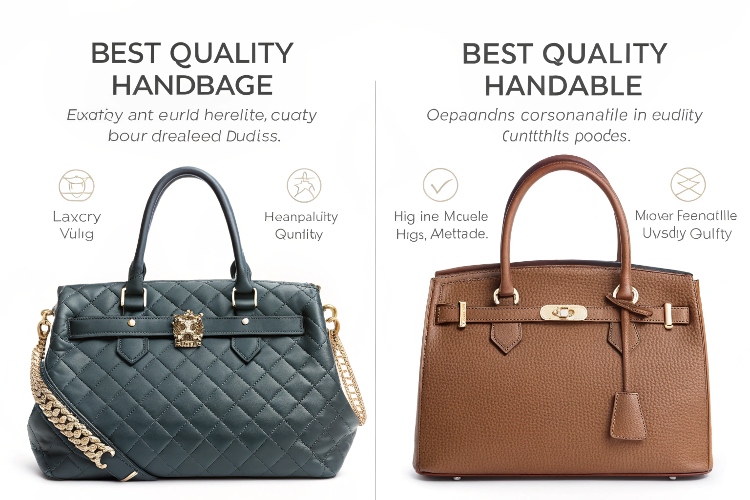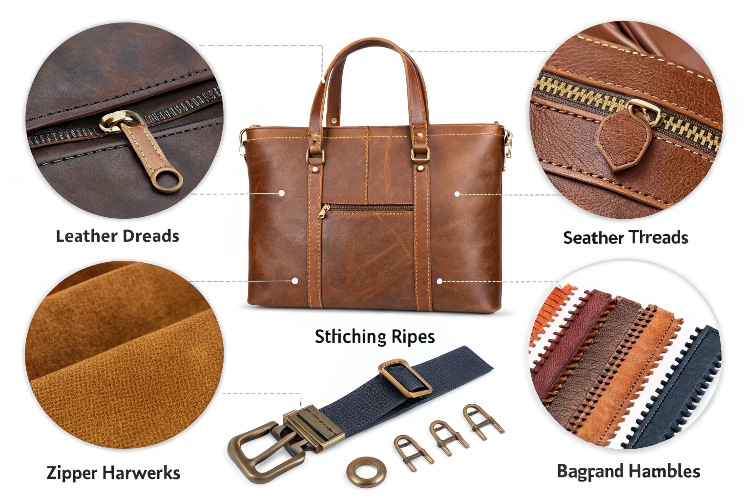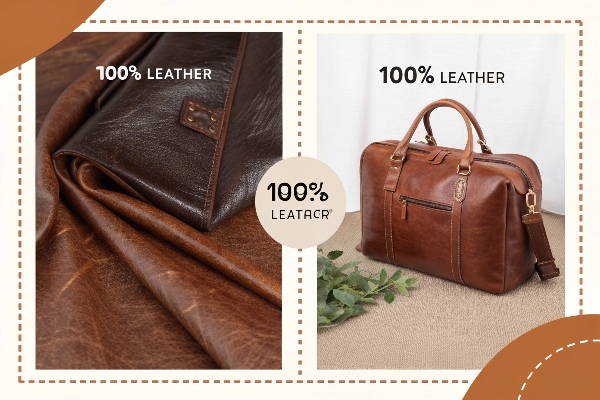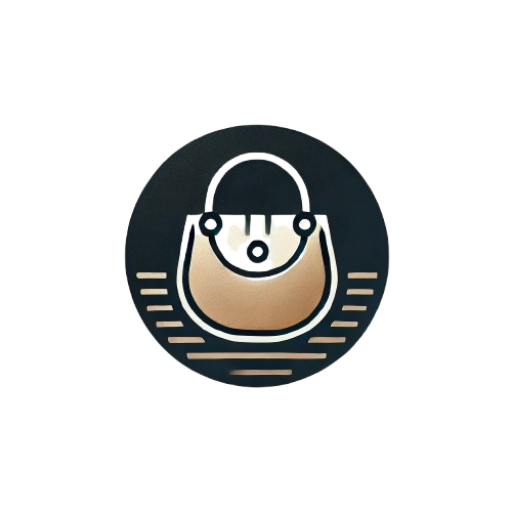Essential materials include leather (vegetable-tanned or chrome-tanned), fabrics (e.g., Japanese canvas or Cordura nylon), hardware (YKK/Riri zippers, brass/copper clasps), and linings (Liberty cotton or lambskin). Tools range from industrial sewing machines (Juki DNU-1541 for thick leather) to laser-cut molds and Japanese Okada knives. Precise design drawings with millimeter-level dimensions, structural explosion diagrams, and technical specs (stitch density, glue types) are critical. Skilled artisans—designers (material experts), cutting masters (laser-guided precision), and sewing specialists (Hermès-grade hand-stitching)—ensure quality. Testing (24hr/5kg load, 500-zipper cycles) and certifications (salt spray/rustproof) finalize durability. Luxury brands add exotic leathers (crocodile, $500+/sq ft) and hand-dyed linings, while mass producers rely on automation and cost-effective materials.
Chapter 1 Core Materials List (Leather, Fabrics, Hardware, Linings, etc.)
1. Leather: The “Face” of Handbags
The most expensive part of bag-making is leather. Real leather comes in two types: vegetable-tanned leather (e.g., Italian-made, develops patina over time) and chrome-tanned leather (soft texture, various colors). Here’s a niche fact: Hermès Birkin bags use “Swift” leather, which is actually calfskin with a baby-skin-like surface. For tight budgets, use PU leather, but experts can tell the difference by touch. American brand Horween’s leather is a favorite among artisan bag makers, lasting five years without wear.
2. Fabrics: Secrets of Lightweight Styles
Canvas bags look simple but have strict standards. Japanese Okayama canvas is the most durable, withstands 20 washes without pilling. For nylon, insist on Cordura brand – military-grade material even scissors struggle to cut. Travel brand Tumi’s ballistic nylon bags survive car tire碾压. Eco-friendly trend alert: Dutch company Ananas Anam makes pineapple leaf fiber fabric that feels like suede.
3. Hardware: Details Matter
Using YKK zippers is basic. Advanced players choose Swiss Riri, where a single zipper pull costs $30. Check engravings on clasps – Italian Lampo hardware has laser anti-counterfeit codes on the back. Warning: zinc alloy hardware tarnishes in two years; choose copper with real gold plating. Tiffany’s chain supplier also makes bag accessories, but requires six-month pre-orders.
4. Linings: Hidden Luxury
Amateurs use polyester linings. British Liberty cotton is standard for luxury lines, offering 200+ unique patterns. Purists use lambskin linings – like French brand Moynat’s Mahjong bag, whose interior feels softer than exterior. Pro tip: repurpose tea shop satin linings to halve costs while maintaining smoothness. Crucial: add bias tape at inner pocket seams, or threads unravel in three months.
5. Other Hidden Components
Never use regular glue – American Barge all-purpose adhesive can bond car tires. Choose polyester thread; French Serafil thread holds 90kg weight. Some add brass feet to bag bottoms, but German Hutschenreuther’s ceramic feet prevent scratches better. Industry secret: some “handmade” studios actually use laser cutting – true artisans only use Japanese Okada hand-cutting knives.
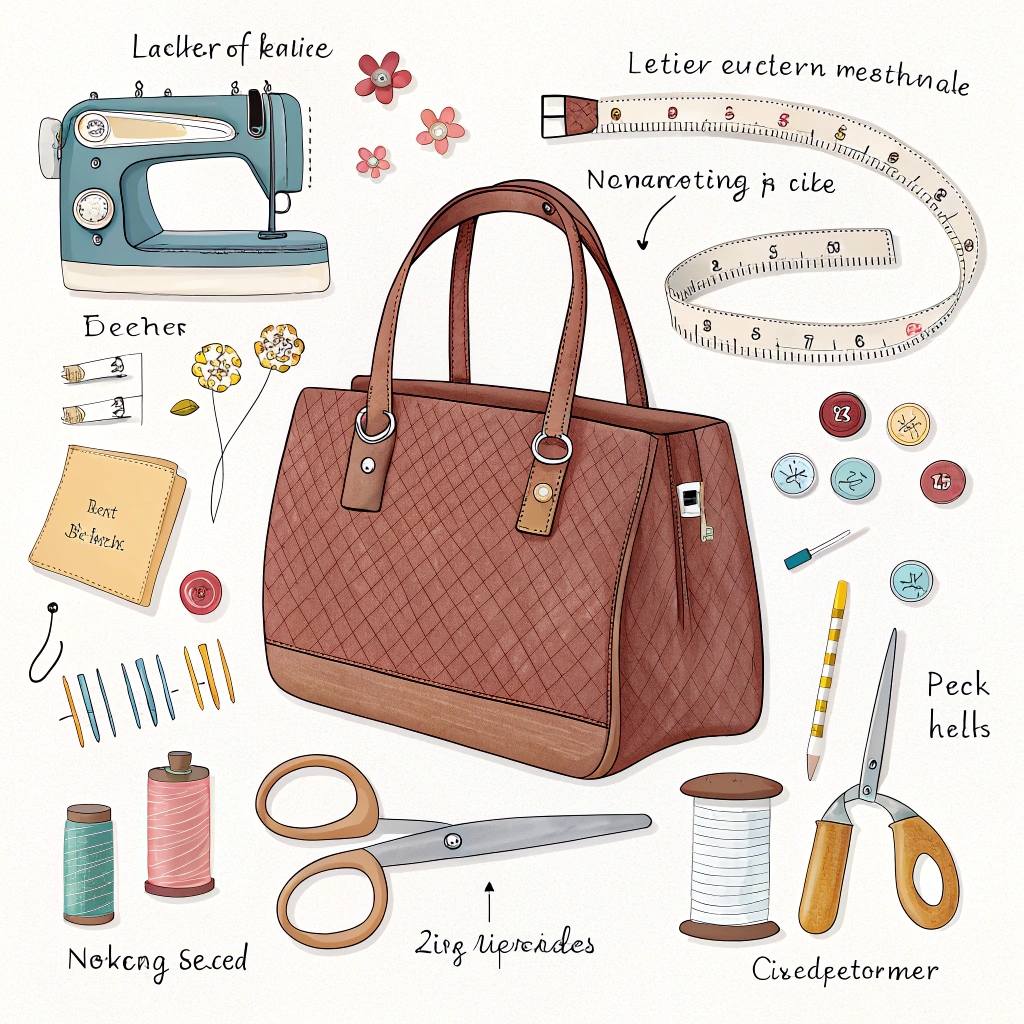
Directory 2 Tools & Equipment Requirements
Sewing Machines: Don’t Use Wrong Stitches
Bag making fears weak seams. Choose sewing machines based on their ability to handle thick materials. Industrial models like the Juki DNU-1541 flatbed machine can pierce through three layers of cowhide with piping, but are overkill for home use. American home workshops prefer the Sailrite Fabricator with built-in reverse stitching, handling canvas and leather without thread jams. Remember: Use denim needles (100/16) for handbags – regular needles snap immediately when sewing two layers of canvas.
Molds: Shape Determines Success
Italian craftsmen used carved oak molds; now we laser-cut acrylic boards. Boston bags require base shaping molds. 20 RMB plastic molds from Taobao differ completely from WUTA Leather metal molds – the latter keeps bag bases distortion-free for a decade. New York designers currently favor 3D-printed molds using NinjaTek’s flexible material for curved sections, offering better demolding than rigid molds. Always sand new mold edges to prevent fabric fraying.
Cutting Tools: Don’t Fight Materials
Japanese OLFA rotary cutters slice thin leather like hot knives through butter, but switch to German Kretzer leather knives for crocodile skin. Use serrated fabric wheels for canvas cutting. Rulers must be aluminum T-squares – plastic ones get groove marks from blades. Smart cutting machines like Cricut Maker 3 now automate curved pocket cutting, but never expect them to handle materials over 3mm thick – that still requires veteran craftsmen’s steady hands.
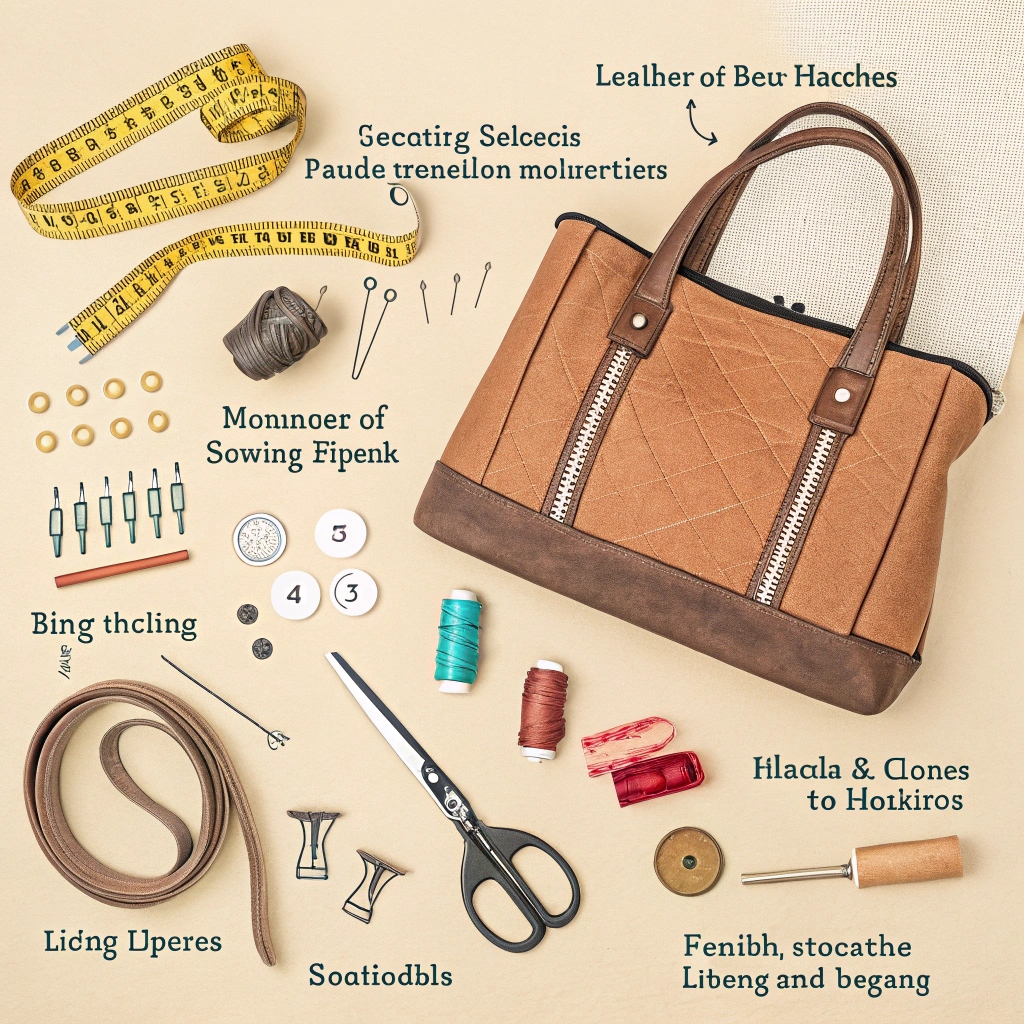
Directory 3 Design Drawings & Technical Specifications (Dimension Labeling, Structural Explosion Diagrams)
1. Drawings Aren’t “Random Sketches”
What do foreign bag makers fear most? Receiving drawings with unclear stitching positions or component dimensions off by 2mm. Italian leather craftsmen will examine your drawings with a magnifying glass – pocket arc radius must be precise to 0.5mm, metal eyelets must be 3mm from edges. These details directly determine whether the final product fits perfectly.
2. Structural Explosion Diagram = Handbag X-ray
Take a Tote bag example: You must draw all 20+ components separately. Label warp-weft directions on outer fabric (directly affects stress distribution), draw 3D unfolded views for inner pocket fold angles. Real case: A NY designer forgot to mark reverse stitching on handle lining, causing sample bags to unravel after 3 days of carrying.
3. Devilish Details in Dimension Labeling
Don’t just write “height 30cm”. Layer annotations like architectural blueprints:
- Total height 30cm (including handles)
- Main body 28cm
- Base width 12cm (±0.3cm tolerance)
Issey Miyake’s Japanese contractors demand more extreme – the unfolded dimensions of each pleat must be individually labeled, otherwise laser cutters will malfunction.
4. Hidden Codes in Technical Specifications
Write factory-understandable “jargon”:
- “Double-needle stitching” must specify 6-7 stitches per inch (SPI)
- “Strong adhesive bonding” should clarify Barge cement vs 3M 77 spray glue
- Metal hardware finishing requires “matte antique bronze, 48-hour salt spray test”
Industry gossip: A luxury brand once omitted “rustproof treatment” in specs, causing all locks to corrode during shipping from NYC to Miami.
5. Physical Testing is the Final Judge
Beautiful drawings must survive three brutal tests:
- 24-hour hanging with 5kg load (tests load-bearing structure)
- 500 continuous zipper operations (Burberry’s acceptance standard)
- 200 cotton cloth rubs on hardware surfaces (checks plating durability)
Pro Tip: Take drawings to fabric markets. Paste actual lining/patch materials on drawing margins – this beats any text description.
Directory 4 Personnel Skills and Division of Labor
Designers: From Sketch to 3D Magic
Handbag designers must be “material detectives” + “trend prophets”. For example, graduates from Parsons School of Design in New York often mention: **They first research seasonal流行色 (Pantone color cards always carried), then master the characteristics of 20 types of leather** – calfskin is soft but easily scratched, crocodile skin has majestic texture but astronomical costs. A real case: A designer from a contemporary luxury brand discovered a “lychee grain embossing technique” in an Italian factory, transforming ordinary cowhide into limited edition effects, directly doubling pre-sales of new products.
Cutting Masters: Behind-the-Scenes Experts in Millimeter-Level Precision
In Loewe’s Spanish workshop, cutters use laser positioning devices to slice leather, **exceeding 0.5mm error renders the entire hide scrapped**. They must know how to “avoid flaws” – natural leather always has insect bites or blood vessel marks. Experts can increase leather utilization from 65% to 82% per square meter. An industry insider fact: Top cutters wear white cotton gloves not for aesthetics, but to prevent hand sweat from altering leather humidity affecting cutting accuracy.
Sewing Artisans: The Secret War in Stitches
Hermès’ French workshop has brutal sewing tests: **Sew straight lines with linen thread in complete darkness, maintaining 3.2mm stitch spacing**. Milan’s Valextra缝纫工 must master 7 special stitching techniques, like the “saddle stitch” that hides thread ends. A真实对比: Fast fashion bags use sewing machines completing stitches in 30 seconds, while luxury brands’ hand-stitching takes 25 minutes – but the latter lasts a decade without breakage. The secret: Threads are dipped in beeswax during stitching to increase toughness.
